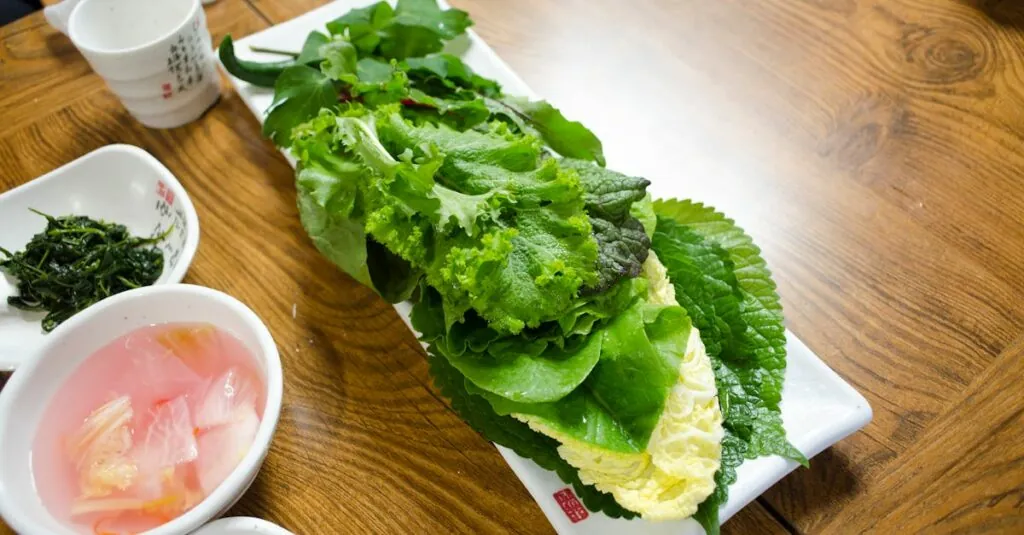Table of Contents
ToggleKale has long reigned as the king of leafy greens, but wait—what’s this? Enter baby kale, the adorable underdog ready to steal the spotlight. With its tender leaves and milder flavor, baby kale is like kale’s fun-loving little sibling, but does it pack the same nutritional punch?
Overview of Kale Varieties
Kale comes in several varieties, each with unique characteristics and nutritional profiles. Traditional kale, often referred to as curly kale, features ruffled leaves and a robust flavor. This variety is rich in vitamins A, C, and K. Its high fiber content also supports digestive health.
Lacinato kale, known as dinosaur kale, presents long, dark green leaves with a slightly sweet flavor. Nutritionally, it offers similar benefits as curly kale, with an emphasis on antioxidants that combat oxidative stress. This variety tends to be easier to digest, making it a favorite among those sensitive to fiber.
Baby kale, in contrast, showcases youthful leaves that are tender and mild. This variety stands out for its high nutrient density, packing in significant amounts of vitamins and minerals while maintaining a lower calorie count. Its softer texture makes it ideal for salads, smoothies, and versatile culinary dishes.
Red Russian kale, recognizable by its vibrantly colored leaves, provides not only aesthetic appeal but also a distinct peppery flavor. Packed with essential nutrients, it contains high levels of anthocyanins and other antioxidants that contribute to overall health.
Different kale varieties cater to various tastes and preparation methods, highlighting their gourmet appeal. Specific nutrients may vary slightly among these kale types, but they all contribute valuable health benefits, supporting a balanced diet. Integrating various kale types into meals enhances nutrient diversity while keeping dishes interesting.
Nutritional Comparison
Baby kale and traditional kale both offer impressive nutritional benefits, but differences exist. Understanding their unique profiles helps in making informed dietary choices.
Vitamins and Minerals
Vitamins A, C, and K are abundant in both baby kale and traditional kale. Baby kale often contains slightly higher levels of vitamin C, promoting immune function and skin health. Traditional kale is known for its robust vitamin K content, essential for bone health. Mineral-wise, both varieties provide significant amounts of calcium and potassium, supporting strong bones and heart health. Iron content, crucial for oxygen transport, is comparable in both. Including either type in a diet contributes to meeting daily vitamin and mineral needs efficiently.
Antioxidants and Phytochemicals
Antioxidants and phytochemicals play vital roles in health benefits. Baby kale features a range of antioxidants, including quercetin, which reduces inflammation. Traditional kale also offers substantial levels of sulforaphane, known for its cancer-fighting properties. Both types contain carotenoids, which support eye health. Moreover, baby kale’s tender leaves make it more palatable for some, encouraging higher intake of these beneficial compounds. Each kale variety contributes diverse antioxidants that support overall wellness, making them versatile additions to meals.
Health Benefits of Baby Kale
Baby kale offers numerous health benefits that contribute to a well-rounded diet. Rich in vitamin C, it boosts immune function and promotes skin health. Increased vitamin K levels in baby kale support bone strength and help with blood clotting.
Nutrient density sets baby kale apart from other leafy greens. It contains antioxidants, including quercetin, which helps reduce inflammation. High levels of calcium and potassium in baby kale support strong bones and heart health. Fiber content aids in digestion, encouraging a healthy gut.
Their mild flavor makes baby kale an appealing option for various dishes. Nutritional versatility allows it to mix seamlessly in salads, smoothies, and soups. Including baby kale in meals can enhance overall nutrient intake and flavor profiles.
Phytochemicals found in baby kale hold potential health benefits. These compounds work in synergy with vitamins to promote wellness. The carotenoids present in baby kale contribute to improved eye health, protecting against age-related vision problems.
Culinary flexibility ensures baby kale appeals to diverse palates. It can be enjoyed raw or lightly cooked, retaining its nutritional value while enhancing meal preparation. Opting for baby kale not only diversifies leafy green intake but also supports a balanced diet rich in essential nutrients.
Selecting baby kale over traditional kale does not compromise nutritional value. The unique blend of vitamins and minerals found in baby kale caters to specific dietary needs while promoting overall health. Integrating baby kale into daily meals presents a strategic choice for maintaining well-being.
Health Benefits of Regular Kale
Regular kale boasts numerous health benefits that contribute to overall wellness. It serves as an excellent source of fiber, aiding in digestion and ensuring a healthy gut. Vitamin K, abundant in kale, plays a crucial role in bone health, promoting calcium absorption and regulating bone metabolism.
Antioxidants found in kale, such as sulforaphane, offer protection against oxidative stress and may lower the risk of chronic diseases. These compounds fight inflammation and support cellular health. Clocking in with high levels of vitamin A and C, regular kale strengthens the immune system and encourages healthy skin.
Calcium content in regular kale supports strong bones and teeth, while potassium helps regulate blood pressure. Each serving provides essential minerals that promote heart health and reduce the risk of cardiovascular disease. Regular consumption of kale fosters eye health, thanks to carotenoids like lutein and zeaxanthin, which protect against age-related macular degeneration.
Vitamin C’s presence enhances iron absorption from plant sources, making kale beneficial for those following a vegetarian or vegan diet. Antioxidants present work synergistically with vitamins, enhancing their effectiveness and promoting overall well-being. The nutritional profile of regular kale makes it a powerhouse for maintaining a balanced diet.
Regular kale’s versatility adds to its appeal; it easily blends into smoothies, salads, and soups, enhancing flavor while delivering essential nutrients. Choosing regular kale provides significant health advantages, ensuring that dietary goals align with wellness priorities.
Culinary Uses of Baby Kale and Kale
Baby kale shines in fresh preparations. Its tender leaves and mild flavor make it ideal for salads. Mixing baby kale into smoothies enhances nutrient content without overwhelming taste. Experimenting with sautéing baby kale in olive oil and garlic creates a quick and flavorful side dish.
Traditional kale, known for its robust texture, excels in cooked dishes. Using it in soups adds depth and nutrients to hearty meals. Roasting traditional kale results in crispy kale chips, a healthy alternative to snacks. Incorporating it into stir-fries combines flavor and nutrition seamlessly.
Both varieties adapt well to various cuisines. Indian dishes benefit from adding kale to curries, enhancing both flavor and health benefits. Mediterranean recipes often feature kale in grain salads, boosting nutrient density.
Baby kale integrates effortlessly into breakfast dishes, like omelets and frittatas, providing a nutrient boost. Traditional kale can transform lunch options; try it in a sandwich or wrap for added crunch and health.
Cooking methods affect both varieties differently. Steaming baby kale retains its vibrant color while softening the texture, making it a suitable addition to pasta. Blanching traditional kale preserves its nutrients for salads and cold dishes.
Utilizing baby kale and traditional kale enriches a balanced diet. Choosing between them depends on the desired flavor and texture. Incorporating these leafy greens elevates meals while promoting overall wellness.
Both baby kale and traditional kale offer impressive nutritional benefits that can enhance any diet. Baby kale’s tender leaves and higher vitamin C levels make it an excellent choice for fresh dishes, while traditional kale’s robust nutrient profile supports overall health in cooked meals.
Incorporating a variety of kale types not only diversifies flavors and textures but also maximizes nutrient intake. Whether one prefers the mild taste of baby kale or the hearty nature of traditional kale, both contribute significantly to wellness. Embracing these leafy greens can lead to a healthier lifestyle and a more vibrant plate.







